![]()
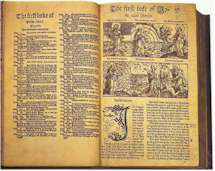 At almost the same time that the flames were consuming William
Tyndale for the heresy of translating the Bible into English, Myles Coverdale was
publishing the first complete English Bible. In 1535, Henry VIII’s Secretary of
State, Cromwell, asked Coverdale to prepare an new translation since Henry would never
sanction Tyndale’s New Testament. Coverdale was not the scholar that Tyndale was but
the demand and need for the Bible was great and Coverdale was willing to assume both the
task and the risk. He was a careful editor and complier and had a natural ability to
select and use whatever materials he had on hand. He used Tyndale’s New Testament and
those portions of the Old Testament that Tyndale had translated and filled in the other
areas with either the Latin Vulgate or the German translations. The Coverdale Bible holds
the distinction of being the first complete English Bible to be printed.
At almost the same time that the flames were consuming William
Tyndale for the heresy of translating the Bible into English, Myles Coverdale was
publishing the first complete English Bible. In 1535, Henry VIII’s Secretary of
State, Cromwell, asked Coverdale to prepare an new translation since Henry would never
sanction Tyndale’s New Testament. Coverdale was not the scholar that Tyndale was but
the demand and need for the Bible was great and Coverdale was willing to assume both the
task and the risk. He was a careful editor and complier and had a natural ability to
select and use whatever materials he had on hand. He used Tyndale’s New Testament and
those portions of the Old Testament that Tyndale had translated and filled in the other
areas with either the Latin Vulgate or the German translations. The Coverdale Bible holds
the distinction of being the first complete English Bible to be printed.
The Matthews Bible
Henry VIII had split with the Catholic Church for the Pope’s refusal to grant him a divorce so that he could marry Anne Boleyn. The Reformation suited Henry’s needs to enlarge the gulf between his people and the Pope as he had set himself up as supreme head of the Church in England. Nevertheless, the danger of being burned at the stake was still a reality for those who dared to give the common people Bibles in English. John Rogers, who had been intrusted by Tyndale with most of his manuscripts, prepared an edition of Tyndale’s New Testament and his own translation of the Old Testament as far as 2 Chronicles. But fearful that King Henry might discover the connection between the two Bibles, he printed under the pseudonym of Thomas Matthews. In 1537, a copy of the Bible was passed to Cranmer, Archbishop of Canterbury and then to Thomas Cromwell who submitted to Henry VIII for approval and permission. The king scanned the book, thinking it might be a useful instrument to weaken the grip of Rome on England and declared his permission to print it. The king did not see the large initials "W.T." that Rogers had placed at the end of the Old Testament in recognition of William Tyndale’s contributions. He did not realize the Bible had any connection with the hated Tyndale, and so he gave the Bible his approval. On the title page it read "printed with the king’s most gracious license." A milestone in the history of the English Bible had been achieved. No longer forced to be sold on the black market and smuggled into England, a Bible in the English language, the Matthews Bible, was now printed with the king’s authorization.
The Matthew Bible is a revision of the Tyndale Bible, supplemented by the Coverdale, with modest changes by John Rogers. All of the Reformation Bibles that were to follow, the Great Bible, the Geneva Bible, the Bishop’s Bible, and the King James Bible are largely indebted to the Matthew Bible.
But freedom for the English Bible did not last long. When Mary Tutor ("Bloody Mary") came to the throne and restored the Catholic religion, the first martyr to be burned at the stake was John Rogers. His crime – printing the Bible in the English language. Once again, the English Bible would be outlawed.
Bibles of the Reformation |
|||
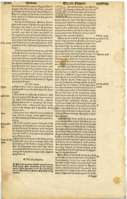 |
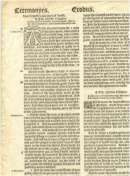 |
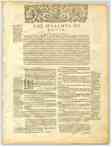 |
|
| Page from a Coverdale Bible, 1538 | Page from a Matthews Bible, 1539 | Page from a Great Bible, 1541 | Page from a Geneva Bible, 1609 |
| Click on the image to see full-page size | |||
Before Queen Mary succeeded Henry VIII, one more significant Bible was translated- the Great Bible. The marginal notes on the Matthew Bible were strongly offensive to the clergy of the day and Cromwell was fearful that its close association with Tyndale might still be discovered, so he asked his friend Coverdale to prepare another version without the offensive notes. With the king’s permission, in 1539 Cromwell arranged for the Bible to be printed in France where they had a superior printing press and much finer paper. The large size of the pages (9" x 15") and beautiful lettering caused the name "The Great Bible." English Bibles were so valuable that it was also called the "Chain Bible" because it was frequently chained to the pulpits to deter theft. Within two years over 20,000 copies had been sold. Every church in England was required to buy one and it remained the primary English Bible for use in churches for 20 years. It was the last Bible printed in the reign of Henry VIII and was authorized by the king. What irony that King Henry at first burned and persecuted the English Bible (Tyndale), then tolerated it (Coverdale Bible), then permitted it (Matthew Bible) and finally commanded it (Great Bible).
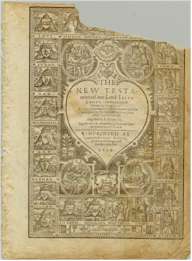 In 1553, after more than 20 years of Protestant domination, Mary Tudor took
the throne in England. She was the Catholic daughter of Henry VIII, and she quickly
brought back the yoke of papal authority and the old religion with a vengeance. She
married Phillip II of Spain- a powerful Catholic monarch who aided her plans to return
England to the fold of the Catholic Church. A flood of migration to Europe began as many
reformers left all behind for a safer climate. Soon Geneva became filled with the deans
and bishops of England and Scotland- men like John Knox, Miles Coverdale, and John Calvin.
In Geneva, these great reformers "could think of nothing which could be more
acceptable to God and as comfortable to His Church, than in the translating of the
Scriptures into our native tongue." These men, along with others like Theordore Beza
and William Whittingham, began pouring over every detail of the texts available as they
painstakingly produced a Bible of such quality that it never needed to be revised. One
advantage at this point was that they had more manuscripts available to them. Their method
of translation worked so well that the translators of the King James Bible later adopted
it.
In 1553, after more than 20 years of Protestant domination, Mary Tudor took
the throne in England. She was the Catholic daughter of Henry VIII, and she quickly
brought back the yoke of papal authority and the old religion with a vengeance. She
married Phillip II of Spain- a powerful Catholic monarch who aided her plans to return
England to the fold of the Catholic Church. A flood of migration to Europe began as many
reformers left all behind for a safer climate. Soon Geneva became filled with the deans
and bishops of England and Scotland- men like John Knox, Miles Coverdale, and John Calvin.
In Geneva, these great reformers "could think of nothing which could be more
acceptable to God and as comfortable to His Church, than in the translating of the
Scriptures into our native tongue." These men, along with others like Theordore Beza
and William Whittingham, began pouring over every detail of the texts available as they
painstakingly produced a Bible of such quality that it never needed to be revised. One
advantage at this point was that they had more manuscripts available to them. Their method
of translation worked so well that the translators of the King James Bible later adopted
it.
Do you know what version of the Bible had the greatest impact on the founding of America? It was the Geneva Bible. This was the translation that accompanied the brave founders of the New World. The Jamestown settlers who landed at Cape Henry in 1607 brought with them the Geneva Bible, and it became the foundation for the first American colony. Did you know? The first African-Americans came to America at Jamestown, not as slaves, but as indentured servants! Many of these worked hard, paid off their debts, and were free men and women years before slavery would become common in the South. Their first exposure to God’s Word was the Geneva Bible.By 1620, the King James Version had been translated, but the Geneva was still the most popular English version. It was the Geneva and the Bishop’s translations that sailed on the Mayflower and arrived at Plymouth Rock with the Pilgrims! |
|
The Geneva Bible was printed in 1560 A.D. and became immediately popular with the common people. It had more than 160 editions being printed as late as 1644 . It was the first Bible to be divided into verses and contained marginal notes largely Calvinistic as well as anti-papal. This household Bible became known as the "Breeches Bible" for its rendering of Gen. 3:7, which says that Adam and Eve sowed fig leaves together to make themselves "breeches." This was the Bible of men like William Shakespeare, John Bunyan and the Puritans. The Geneva Bible was the first English Bible in use in America, landing with the Pilgrims at Plymouth Rock and used at the early settlement of Jamestown.
With the early providential death of Bloody Mary Tudor in 1558, the final hope of the Pope and the Catholic Church to control England died with her. Over 300 men, women, and children had been burned at the stake for refusing to deny their faith and return to the Catholic Church. Mary’s half-sister, Elizabeth, the daughter of Henry VIII and Anne Boleyn, had been raised Prostestant and she quietly returned England back to the Protestant fold. Although their were disputes between the Puritans and the Anglican Church, the years under Elizabeth, 1558-1603, firmly established the Reformation in England and forever broke the papal authority over the people. The common people had a Bible in their own language that lifted them from the dark depths of ignorance into the light of the truth of God’s Word. They would never be the same.
The Great Bible was still the official Bible of England and the popularity of the Geneva Bible was undermining its prestige. So Matthew Parker, Archbishop of Canterbury, organized a committee of bishops to undertake a new translation of the Bible that would not undermine their authority as the Geneva did – therefore, the name "The Bishop’s Bible". It was large in size, had numerous woodcuts and was cumbersome as well as costly. Although it followed the Great Bible for the most part it showed marked passages of the Geneva Bible, the one it was supposed to replace. It was not suitable for private use and was not even satisfying to the scholars. The title page had a woodcut of Elizabeth but she never gave it any public recognition or sanction. After its publication in 1568, the Bishop’s replaced the Great Bible as the standard in churches, but of all the Reformation bibles it was the most inferior in quality as a translation.
Copyright © 1998-2002, The Ancient Page